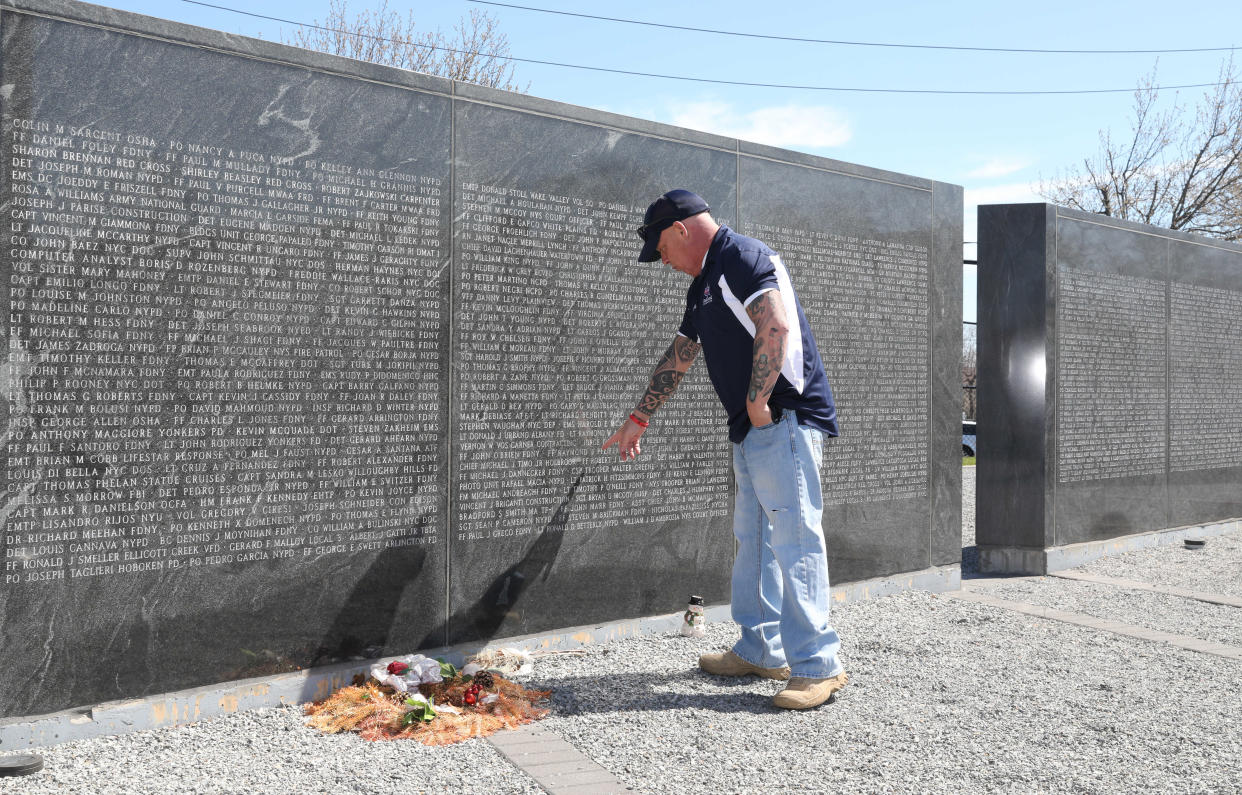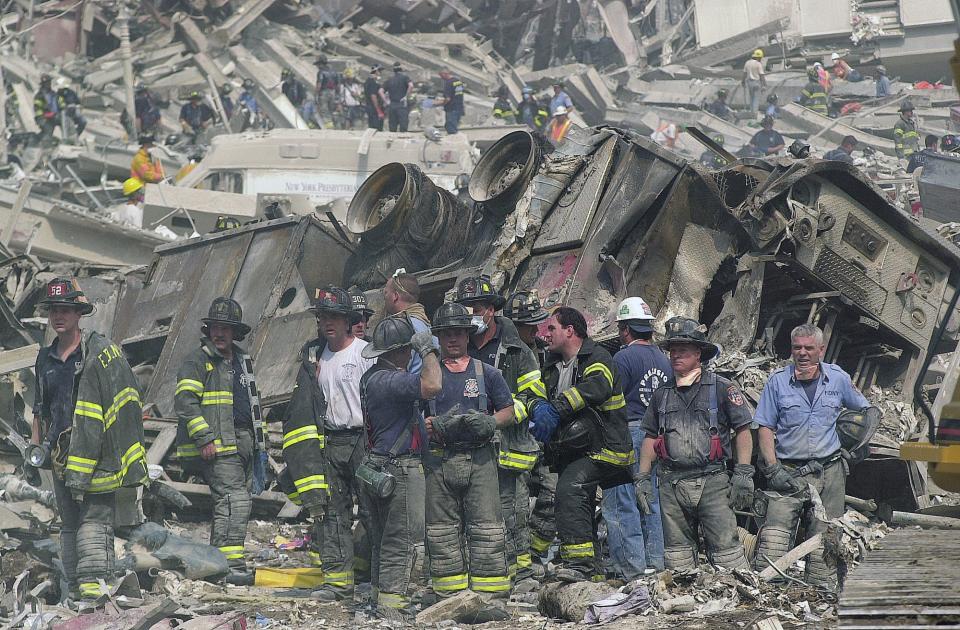9/11 jeopardized first responders’ health. Nearly 20 years later, COVID-19 brought new risks.

John Feal led scores of trips to Congress with 9/11 responders and comedian Jon Stewart to fight for health treatment and benefits for those who rushed toward danger on Sept. 11, 2001, and continue to suffer health effects.
He remembers the early – and wrong – advice the EPA gave those working on the rescue and recovery at Ground Zero: that the air was safe to breathe, that what was really a toxic swirl wouldn't cause permanent harm.
Feal's experience fighting for sick 9/11 responders and the extension of the 9/11 James Zadroga Health Act taught him the value of a mask.
So, nearly two decades after 9/11, when COVID-19 reports in the U.S. began to trickle in and experts said masks weren't necessary to protect against a potentially deadly danger, Feal had reason for suspicion.
In early March 2020, he fashioned his own face mask out of paper towels, Scotch tape and rubber bands.
People asked him why he was wearing the makeshift contraption around his face.
“You’ll see,” the 54-year-old told them.

COVID-19 threat rattled 9/11 community
For 9/11 first responders – as well as volunteers and survivors – the COVID-19 pandemic presented another crisis that left them feeling vulnerable.
There were marked differences, of course: One was an attack that blindsided a nation – a terrorist act. The pandemic was a worldwide phenomenon that crept to our nation even as we still felt unprepared.
But for the responders who rushed toward danger that bright sunny Tuesday in September 2001, the COVID-19 threat was all the more magnified by their resulting health vulnerabilities, their continued position on the front lines and the echo of trauma.
“We had an exodus,” said Oren Barzilay, president of Local 2507, the union that represents emergency medical technicians, paramedics and fire inspectors in the New York City Fire Department. The spate of retirements among FDNY EMTs and paramedics continues. “Our members are leaving in droves. It’s just too risky.”
The risk was far from imagined. Nearly half of FDNY medical responders ended up with COVID-19, said Barzilay, whose union has more than 4,000 members.
Four EMTs who served during the 9/11 rescue and recovery mission – Gregory Hodge, 59; John Redd, 63; Idris Bey, 60; and Richard Seaberry, 63 – had died of COVID-19 before April 2020 was through.
FDNY EMT Evelyn Ford, 58, died from COVID-19 on Dec. 22, 2020.
Even now, as vaccines ramp up and COVID-19 cases drop in New York, the virus remains a threat.
NYPD Officer Michael Mundy, 45, died on April 28, 2021, from the virus, according to the department's Twitter account. He had joined the force in July of 2001, a mere two months before the terrorist attacks.
Even among 9/11 responders who never got COVID-19, the pandemic exacerbated one of the key health conditions caused by rescue and recovery efforts after the Sept. 11 terrorist attacks. Post-traumatic stress disorder has been the most common health concern for those who have suffered the health impacts of 9/11.
“They think about when – not if – but when I’m getting 9/11 cancer,” said Feal, a construction supervisor at Ground Zero who was severely injured when a steel beam fell on his foot. “Now it’s a double whammy. Now they are looking over their shoulder: 'When am I gonna get COVID?'”
But the role first responders play in times of crises forms another link between then and now: They rushed into the heart of unfolding danger, leading to disproportionate risks among their own ranks.
Live COVID-19 updates: U.S. supports lifting patent protections for vaccines; once-grim CDC projections now 'quite hopeful' for summer
When will everyone be vaccinated for COVID-19? Here's how the vaccine rollout is going
Risk from a new enemy
"There was so many schools of thought when the pandemic began," said New Rochelle Fire Chief Andy Sandor, who worked at Ground Zero after 9/11. "At first, we didn't want to respond to emergency calls in hazmat suits so we didn't create fear."
Many active-duty firefighters and first responders were just trying to keep up with how to respond to emergencies.
At the New Rochelle and White Plains fire departments firefighters also respond to emergency medical calls.
In those early days of the pandemic, their own exposure to the virus didn't really cross their minds, White Plains firefighters said during a recent roundtable interview.
Sarah Woods said her husband, Peter, made this connection right away. When, in March 2020, a New Rochelle man fell ill with one of the first documented cases of COVID-19 in the area, he knew he and his fellow 9/11 first responders would be at risk from a new enemy.
Peter Woods was part of the NYPD Harbor Patrol when the planes hit the World Trade Center. By 2020, he was battling leukemia, respiratory ailments and other 9/11-related illnesses. From the time COVID-19 came to the U.S. until the summer, Woods went into an immediate quarantine and almost never left the house.
Sarah Woods recalled how careful her husband had been during 9/11.
"He was there for at least 24 hours, and I remember him coming home and getting changed in the garage and took a shower," his wife, Sarah, told The Journal News/lohud.com, part of the USA TODAY Network.
"He was covered in debris, and he told me and our family not to go anywhere near the clothes."
While Woods remained safe from COVID-19, he died at age 59 on Jan. 9, 2021, from complications of leukemia.
Others, though, did not escape the virus.
FBI Special Agent Thomas J. Mohnal died from COVID-19 in February 2021 at age 66. Mohnal, who testified before Congress alongside Feal on behalf of the 9/11 Victims Compensation Fund, had battled 9/11-related cancer for years. The Virginia resident was on his way to respond to the World Trade Center attacks as an explosives expert when he witnessed the plane crash into the Pentagon.
Cancer and respiratory disorders like asthma and COPD are among the most common illnesses linked to 9/11 recovery efforts. Those are also among the conditions that put people at a higher risk for severe bouts of COVID-19.
Mohnal was just one of many who battled through 9/11 illness and then COVID-19.

For recent 9/11-related deaths, COVID-19 is a common theme
Feal said early on he was worried the respiratory virus spreading around the world would wreak havoc on those in the 9/11 community.
He hates that he’s right.
Feal tracks all 9/11-related deaths, keeping a Sept. 1 to Sept. 1 count each year. Every Sept. 12, they are honored at a ceremony at 9/11 Responders Remembered Memorial Park in Nesconset, New York.
According to Feal, since Sept. 1, 2020, about 158 people have died with a 9/11 illness as a contributing cause. Of those, he has so far documented 32 COVID-19-related deaths.
And it’s only April.

The average age for a 9/11 first responder is now about 59½, adding yet another risk factor for poor COVID-19 outcomes, on top of the common respiratory damage and cancers that 9/11 illness often brings.
Michael Barasch, whose law firm has represented thousands of 9/11 Victim Compensation Fund recipients, said that by April, he had lost 100 clients – 9/11 responders and survivors – to the virus.
Dr. Michael Crane, medical director of the World Trade Center Health Program Clinical Center of Excellence at Mount Sinai, said that so far, as a cohort, the 9/11 community hasn’t shown a higher vulnerability to contracting COVID-19. But the data is limited. “It’s an incomplete picture,” he said.
“I’m crossing my fingers here,” Crane said. “It’s a dangerous virus.”
But, Crane said, "individually there are people who have had terrible times."

Seeking their shots
Barasch began pushing states early on in vaccine distribution to provide vaccination access to those with 9/11-related illnesses.
In New York, 9/11 responders with related illnesses didn’t become eligible for COVID-19 vaccinations until February, at the same time others with comorbidities could get the shot.
One of those eager to get the vaccine was Richard Palmer Jr. Then part of the New York City Department of Corrections, Palmer worked at the morgue operation for the World Trade Center after the Sept. 11, 2001, terror attacks. Now 50 and retired, he has undergone a quadruple bypass and eight stents placed in his heart; he suffers from asthma and other respiratory conditions.
He got vaccinated against COVID-19 shortly after the state made 9/11 responders eligible. But he believed he and others should have had access sooner.
World Trade Center health programs, which exist around the nation, haven't been given direct access to vaccines for their at-risk patients.
On Long Island, the Suffolk County Police Department arranged a special vaccination pod in mid-March that focused on getting shots to 9/11 responders with comorbidities.
Barasch saw states' delay in getting vaccines to 9/11 responders as a mistake.
"You want to send the message to them that they won’t be left behind the next time there’s a crisis," Barasch said, referencing the bitterness that lingers over the EPA's failures. "Why should they risk their lives if they think their families will be left in the lurch?"
Palmer said he will continue to mask up and practice COVID-19 precautions. “Just because you got the vaccine, you can’t let your guard down.”
But vaccine hesitancy exists in the first responder community too. Barzilay said that just about 50% of his union membership has been vaccinated.
He blamed vaccine skepticism on a string of government failures to protect first responders – from the infamous "air is safe" proclamations that then-EPA Administrator Christine Todd Whitman made in September 2001 to the PPE shortages amid COVID-19 and guidance in March 2020 that N95 masks only needed to be used when responding to respiratory distress calls.
"It’s just frustrating that when you have public officials, people who are policy officials, giving us false information," Barzilay said. "The air wasn’t clean on Sept 11. The air wasn’t clean around COVID."
The mistrust, he said, "lingers in everybody’s mind."
John Feal: Sicker and sicker
Feal knows firsthand the risk from COVID-19.
In March of 2020 when the pandemic hit New York, Feal and lawyer Michael Barasch produced a public service announcement geared toward the 9/11 community, many of whom were already dealing with serious illnesses and strained immune systems.
Feal and Barasch, whose firm represents hundreds of 9/11 responders and survivors, wanted to encourage the 9/11 community to follow all safety protocols as COVID-19 spread.
They told those dealing with or at risk of 9/11 illness: “Heed the advice of the experts.”

A week after the video was shot in Manhattan, Feal came down with a stomach virus. He felt sicker and sicker. Breathing problems started. Within 10 days, he was in the ER with double pneumonia and a COVID-19 diagnosis.
He lost his sense of smell and taste. He was wiped out. He still has memory loss from his hospitalization.
“My chest was black and blue,” Feal said. He was told that he was punching himself in the chest in his sleep, apparently to help himself cough and breathe.
He struggled with complications, and has continued to struggle with other medical conditions he thinks were exacerbated by COVID-19.
Feal said that he’s tried to help others after his battle with the virus. He’s donated convalescent plasma for treatment of COVID-19 patients eight times.
Feal, who received his second Moderna vaccination April 1, said he’ll also continue to wear a face mask.
And he will mandate face coverings at the annual Sept. 12 ceremony at 9/11 Responders Remembered Memorial Park that honors those lost in the past year from 9/11-related illnesses.
“Nobody’s going to get these people sick on my watch.”
This article originally appeared on Rockland/Westchester Journal News: 9/11 illnesses, COVID-19 a tough mix for first responders, survivors

